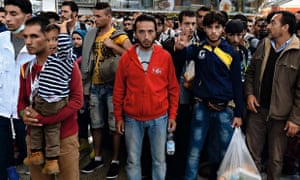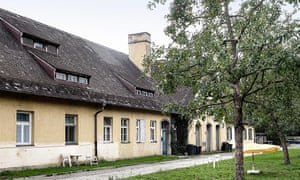"Think About How We Died Here"
"Where else should I live with my three children? On the street? This is better. What can I do?"
"It’s a catastrophe here, the people are aggressive, they drink."
Romanian refugee woman, mother of three children, Dachau, Germany
 |
| Refugees at Munich railway station last week. Photograph: AFP/Getty Images |
"They’re the more vulnerable members of our society. In that way, the buildings with their historical burden can be used for a socially meaningful purpose."
Florian Hartmann, mayor, Dachau
 |
| A building in the Dachau herb garden, which now houses 50 refugees and homeless people. Photograph: Frank Bauer for the Guardian |
"It’s been hard to find a flat. Whenever I say, I’m from Afghanistan, the reply is: OK, right… no."Ashkan fled his city in Afghanistan after the Taliban threatened to kill him. Now he lives in a part of Dachau, the concentration camp where Nazis conducted agonizing medical experiments on helpless camp inmates, murdering 42,000 human beings, mostly Jews. The complex where Ashkan now lives was once a teaching institute of alternative medicine within a slave-labour plantation called the "herb garden". Ashkan's residence bears no resemblance to the dark horrors of the past.
"I had everything [in Herat, Afghanistan, before his father was killed by the Taliban]: a motorbike, my family, friends whom I saw every day. I lived like a prince.
"Here you don’t have to worry that you leave the house in the morning, and you’re dead. You don’t have to worry that someone will suddenly kill you. That’s better."
"I just wanted a roof over my head."
"I go to work, I come home, I go to work."
Ashkan, 22, Afghan refugee, Dacha, Germany
"It wasn’t our fault, but our grandparents were part of it. In a way, the refugee crisis is a chance to do something better. On the other hand, people expect too much from us because of our past."
Peter Himmelsbach, 28, Heilbronn visitor to Dachau memorial site
"For me, it’s not very welcoming to house refugees in a place that symbolizes torture and death." Gabriele Hammermann, director, Dachau concentration camp memorial site
His new residence has been personalized with an Afghan bedroll, a Persian rug and an Afghan flag.
He knows nothing personally about the dreadful past that haunts the place as a memorial to man's inhumanity to man. The pressure to provide shelter for refugees and the homeless existed well before this recent influx of countless refugees. The shelter Ashkan is now housed in is situated across the road from the main Dachau camp, surrounded by watchtowers and walls with barbed wire atop.
The camp custodians would prefer the camp be transformed to a memorial site. Amazing, actually, that this hadn't happened years ago. Town officials, on the other hand, insist the space is needed for those with nowhere else to go. And, in this instance, town officials are right. The structures and all that surround them exist as a reproach and a reminder of what had occurred; nothing will obliterate that fact. And it is dismally appropriate that the homeless and desperate refugees find haven in a place that once destroyed human life with abandon.
In Munich, which has long become a Muslim enclave, toys are being handed out to Syrian refugee children while in other places in Germany attacks on asylum shelters take place, terrifying refugees. The interior ministry has logged 202 refugee shelter attacks in the first half of 2015, while German media report dozens of attacks through July and August. The high number of refugees arriving in Germamy seeking refuge causes fear in 46% of East Germans and 36% of West Germans, according to a survey.
Little wonder, since Germans have witnessed a slow and disturbing transformation of their culture, their religion, their language and their social mores with the gradual (up to the present) influx of Muslims emigrating from their countries of origin (originally Turks brought over as low-paid labourers who were expected to return to Turkey but never did) to now amount to almost six million Muslims resident in Germany. Living in enclaves entirely foreign in nature to Germans.
There is mordant irony there: six million Jewish lives annihilated with punctilious deliberation; six million Muslims compassionately given permission to live among Germans as equals.
Dachau continues to present to Germany the opportunity to ensure that younger Germans know their country's full history throughout World War II. A group of air force officers-in-training enter the barracks, blue berets removed in a gesture of respect. It is explained by 27-year-old Lieutenant Roman Lehmann that this visit represents part of their basic military training: "It’s a way to try to ensure this doesn’t happen again in the future. Concentration camps as such happening again, that’s probably unlikely.
"But if you look at the situation of refugees in Germany right now for example, there’s been a rise in rightwing tendencies. We’ve seen arson attacks on refugee shelters. We need to develop this sense of: this is where it can lead, we’ve already experienced this before", he explained earnestly. The small community of 45,000 Dachau residents houses about 350 refugees in the town's communal shelter, and there are plans to open another for one hundred in months to come.
The town is not really contemplating moving the 50 people who have been given housing in the Dachau camp. The director of the memorial site now feels a compromise that would continue to give shelter to the refugees but would ensure that besides the residential space set aside, the rest of the camp be used for exhibitions and seminars, would serve its memorial purpose.
In East Germany, despite calls to settle more refugees where buildings are empty reflecting the locals moving to the west following jobs, protests against such shelters occur. The former GDR was the site of 47% of all racist attacks in Germany, despite that only 17% of the country's population live there. The area of Dachau called the herb garden where the refugees now live, was part of an effort to invent a "German" medicine in reflection of the fascist distaste that mainstream medicine was held to be influenced by Jewish doctors, and thus tainted.
In the greenhouses, the fields and laboratories surrounding the buildings, some 1,600 mostly Jewish slave labourers grew and processed medicinal herbs and edible flowers for the Wehrmacht and the German market. After their labours the prisoners would be returned to the main camp. Medical experiments such as submerging inmates in icy water until death, occurred in the main camp. Milder forms of torture took place around the herb garden though prisoners were known to be shot there by the SS guards.
Labels: Germany, Holocaust, Islamization, Muslims, Refugees
0 Comments:
Post a Comment
<< Home